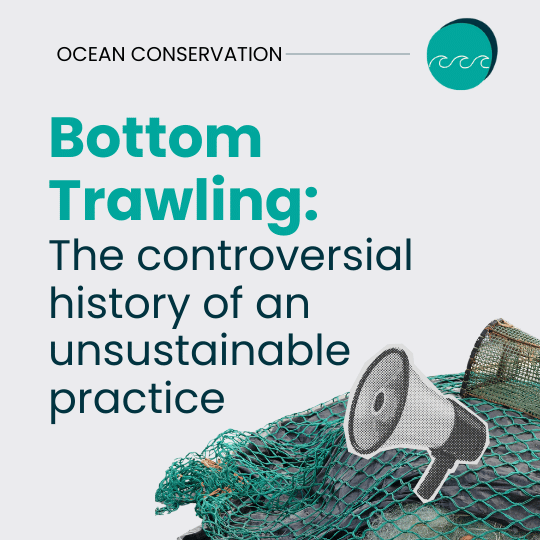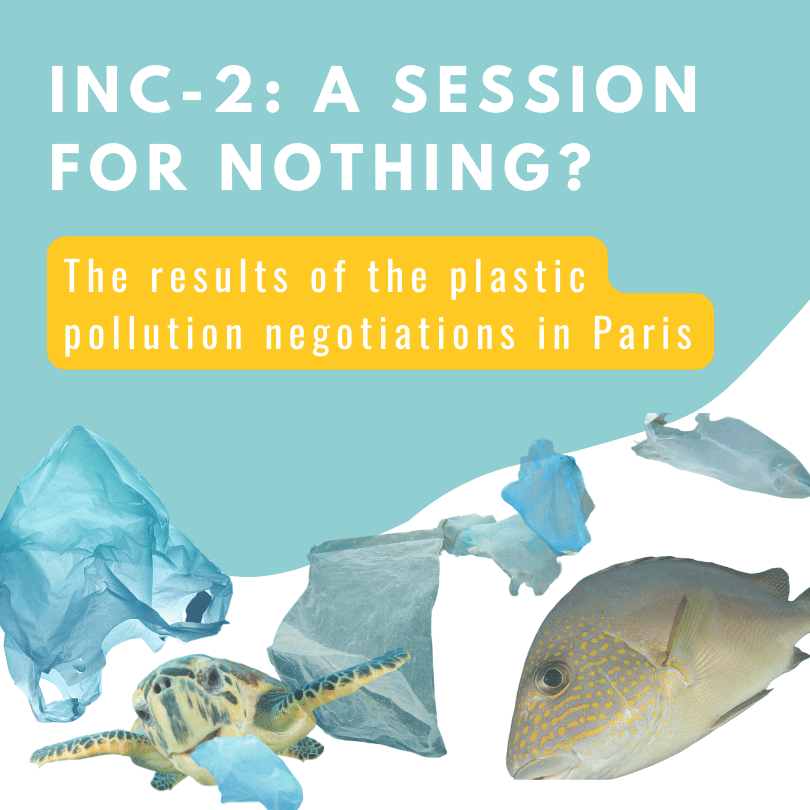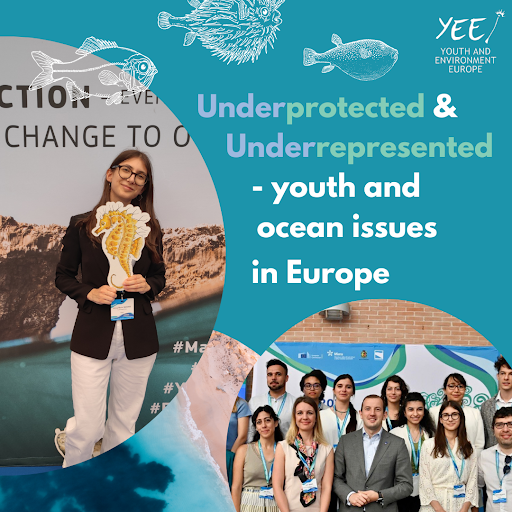Reflections on INC-5: A Delayed Milestone, not a Failure
This session was supposed to be the “end of the beginning,” when the world would step out with the first-ever global plastic treaty.
- February 3, 2025

Written by
Shellan Saling
Explainers
In treaty negotiations, brackets indicate text that is still under discussion and might be added, deleted or revised. They help show areas where agreement has not been found yet. This allows negotiators to know which part of the text needs more debate.
A non-paper is an informal document used in diplomatic negotiations to propose ideas, outline potential solutions, or highlight issues without a formal position.
Share this article
Expectations ran high as delegates convened in Busan, South Korea, from 25 November to 1 December 2024. They met for the fifth session of the Intergovernmental Negotiating Committee (INC) to develop a legally binding instrument on plastic pollution, including in the marine environment.
This session was supposed to be the “end of the beginning,” when the world would step out with the first-ever global plastic treaty, which did not happen. However, calling INC-5 a failure would overlook the complexities of negotiating and treaty-making and the leap forward that took place at INC-5.
Laying the Foundation for INC-5
The intersessional period between INC-4 and INC-5 was busier than ever, marked by the agreed-upon intersessional work of two working groups. With the revised zero text widely declared unworkable due to the text mostly being bracketed, INC Chair Luis Vayada technically went beyond his mandate with good intention by issuing informal drafts called non-papers which aimed to bring member states to an agreement. The final one, non-paper three, outlined a treaty with proposed ways forward to INC-5 and COP-1. As a result, there was a lot of uncertainty over which paper would be used as a starting point for negotiations.
Familiarity with the past at the beginning of INC-5
As the plenary opened in Busan, familiar obstacles emerged. Low-ambition countries applied delay tactics, resurrecting the ever-prolonged debate over the still-in-draft form rules of procedure. Hours of discussion yielded few breakthroughs, but eventually, the chair and most member states agreed to continue with the draft rules of procedures, meaning all decisions would still require consensus. There was also a debate about whether negotiations should start from the revised zero draft or non-paper three. The consensus ruled in favour of starting at non-paper three as the negotiating text with the caveat the Member States could propose additional text. This allowed delegates to break into contact groups earlier than in previous sessions, a small but important step to keep discussions focused on substantive issues. Two new drafts of the treaty (non-papers) were produced throughout INC-5 with an agreement to resume session 5 with the “Chair’s Text” agreed by member states.
From an outsider’s perspective, the negotiations may have appeared to spin in circles. This was further reinforced by major news reporting INC-5 as a failure with headlines such as, “U.N. treaty talks collapse”, “Countries fail to reach agreement in the UN plastic talks”, or “Negotiators fail to reach an agreement on a plastic pollution treaty”, painting a picture of deadlock and disappointment. Such characterisations, however, miss a critical nuance: incremental progress often defines the rhythm of international treaties. Expectations to finalise the first-ever global plastic treaty within two and a half years of UNEA Resolution 5/14 at UNEA 5.2 in March 2022 were always ambitious, as they should be to address the urgency of this crisis. Naturally, there was disappointment. Many people who had been working on this process for a long time knew in the back of their minds that INC-5 was going to be a steep uphill battle to finalise a treaty and that additional INCs were likely.
Despite these challenges, INC-5 marked a subtle, yet significant turning point. For the first time, we saw a clear majority emerge with more than 100+ countries uniting in wanting a treaty that addresses the full lifecycle of plastics that includes production limits. This is in addition to many stakeholders and observers including youth, children, scientists, businesses, indigenous, frontline communities and rights holders having voiced this from the very beginning of negotiations, if not long before the treaty negotiations began. This emerging consensus on reduction-oriented measures contrasts sharply with the minority of member states wanting strictly a waste-management treaty, an approach that has been long favoured and known by less ambitious member states and industry stakeholders. Had negotiators settled for a weaker, waste management-focused deal in Busan, the world might have walked away with a quick agreement, but at the cost of ignoring scientists and jeopardising lasting solutions to protect vulnerable groups from the impacts of plastic pollution. Growing voices argue that no treaty is better than a weak one.
Lessons from History
It is critical to look at these negotiations in the history of multilateral environmental agreements (MEAs). Building on decades of advocacy and awareness around plastic pollution, these negotiations are moving at a pace that reflects both urgency and complexity. While addressing the plastic crisis with this treaty is extremely urgent with current predictions seeing plastic production triple by 2060 without intervention negotiations are still going at a swift pace compared to other MEAs. Notably, the Paris Agreement took 6 years to negotiate, building from the momentum of decades of climate talks. The most recent High Seas Treaty, finalised in 2023, took nearly two decades of discussions and five years of formal negotiations. Countless other MEAs have taken more than two years to be negotiated. Even though the plastic treaty negotiations are being extended to 2025, if countries can agree, it would remain one of the fastest global environmental agreements ever forged. Based on INC-5 and the unity that has converged it is possible for countries to agree by the end of 2025, if not sooner.
Challenges and looking ahead
Negotiations are still expected to overcome plenty of challenges before reaching a conclusion. Observers were locked out for nearly half of the negotiations and must be included in all negotiations going forward. Youth delegates (35 and younger) continue to lack power and decision-making authority over their own future. Whether part of government delegations or observers, young people and future generations are set to be the most impacted by the plastic crisis. Some of the most contentious sections of the treaty include those addressing hazardous chemicals in plastics (Article 3), sustainable production (Article 6), and funding mechanisms (Article 11)., yet are some of the most important articles in the treaty. They must be ambitious with bold targets and robust funding mechanisms. Ultimately, this treaty will have a significant impact on our generation and those to come. It is up to us to decide how we want to change history.
While we await when and where session 5 will reconvene, it is evident the debate is no longer confined to the technicalities. It is a fundamental question of whether the treaty will embrace meaningful reductions in plastic production, supply, and demand and provide strong protection for vulnerable communities and ecosystems. Resisting compromise on ambitious goals and ensuring active engagement from all stakeholders, including youth, will determine the treaty’s trajectory. History suggests it will take time, and INC-5, far from failure, may be remembered as another critical stepping stone toward a strong, science-based, ambitious global plastics treaty.
There are still many unresolved questions and concerns, including procedural matters and the critical issue of determining which document will serve as the basis for negotiations in section 5.2. Options include using the Chair’s text, combining different drafts, or allowing countries to make further changes to the text. A final critical question remaining from INC-5: Is multilateralism the right path forward for this treaty? While consensus has been foundational for treaty-making, the urgency of addressing the plastic crisis is a reason to look at alternative approaches such as voting on unresolved issues. Although untraditional in the treaty-making process, it could speed up the progress towards reaching an agreement.
The path forward requires bold and daring action to keep up the momentum by reconvening as soon as possible for session 5.2 because our generation and those to come are on the line if we do not get an ambitious treaty as soon as possible.
More articles about marine pollution
Our mission
 YEE aims to unite environmental youth non-profit organisations in Europe in order to enhance international cooperation, increase knowledge about the climate crisis, raise awareness of environmental problems and to strengthen participation of youth in environmental decision-making.
YEE aims to unite environmental youth non-profit organisations in Europe in order to enhance international cooperation, increase knowledge about the climate crisis, raise awareness of environmental problems and to strengthen participation of youth in environmental decision-making.
Get in touch
Vinohradská 2165/48
120 00 Praha 2 – Vinohrady
Czech Republic
E-mail: yee@yeenet.eu


Financially supported by the European Youth Foundation of the Council of Europe. The views expressed do not necessarily reflect the official position of the Council of Europe








